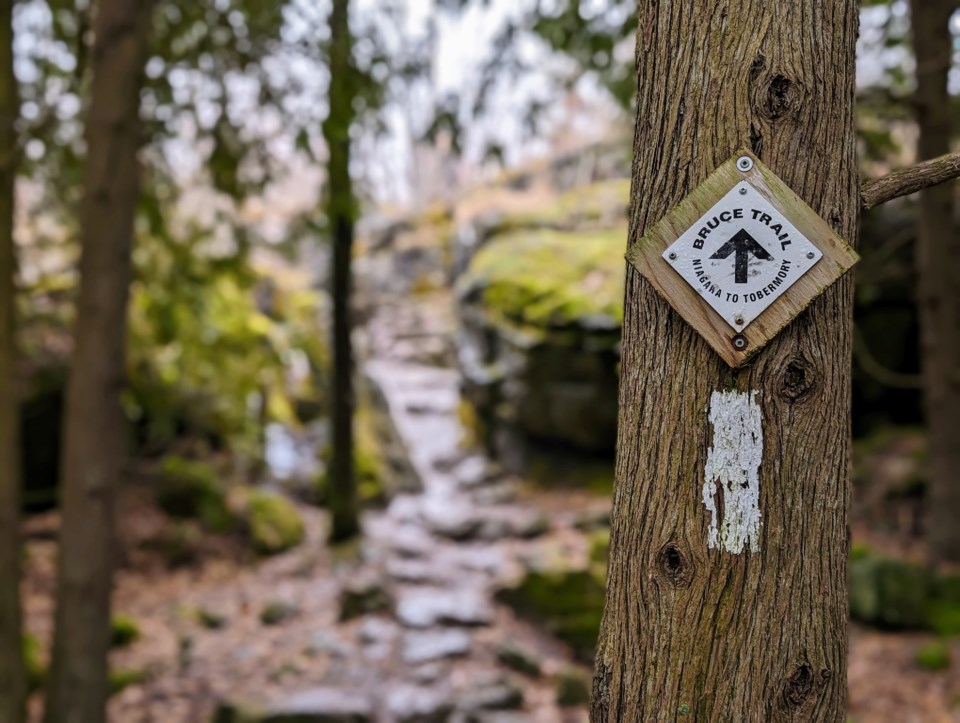The man in charge of the Bruce Trail says his organization is working to establish campsites all along the 900-kilometre-long corridor, with the goal of supporting straightforward thru-hikes by 2030.
Unlike many other long-distance trails in North America, camping along the Bruce Trail isn't allowed except for a few designated spots. Most people who hike the entire trail do so in sections over months or years. Those who hike the trail in one shot, from Niagara to Tobermory, have to carefully plan their nights between those sites, B&B and cabin rentals, and nearby towns.
That could change soon.
Under its 2030 Strategy, the Bruce Trail Conservancy (BTC) says it aims to "deliver a plan that allows people to thru-hike the entire Bruce Trail more easily."
The Trillium asked CEO Michael McDonald if that meant creating camping spots so frequent that hikers could stay on trail the whole time.
"I'm going to go on record as saying a strong yes. That was always the original vision of the Bruce Trail and we're going to work hard to make sure that that happens," he said. "I think the Bruce Trail is absolutely a world-class trail already, but this will help further cement that."
The Bruce's future doesn't look like, say, the Pacific Crest Trail, where hikers can plunk a tent down anywhere that's appropriate. The trail's "overnight rest areas," as defined by the Niagara Escarpment Plan, will have to be placed at least 10 kilometres away from one another, not directly on the main trail, away from roads and scenic points (to discourage abuse by non-hikers), and without sewer or electrical services.
"Such an area would normally consist of three to six clearings for tents, a fireplace, a water source and a latrine," the plan states.
A terrestrial ecologist is currently working with the various Bruce Trail clubs (the volunteers in charge of each section) "to try and pick the optimal spots where that could happen," McDonald said.
Campsites will only be on BTC-owned land, he stressed.
"The truth is, as we become a more mature organization, we're now coming to the point where we own enough land that we can pull this off and make it happen," he said.
The BTC currently owns about 15,000 acres of land along the Niagara Escarpment, or 70.6 per cent of the trail. But it's far from done — another part of the 2030 plan aims to "urgently secure land within our conservation corridor."
That's happening "at a pretty rapid pace," McDonald said.
About 630 private landowners currently allow the trail to cross their property, he said. The BTC often reaches out and offers to buy part of their land or their entire property, often via government funding through the Greenlands Conservation Partnership, he said.
"Everyone thinks of us as a hiking trail, but the truth is, we're building a massive conservation corridor that goes all the way from Queenston to Tobermory, and our mission is to secure the land around the trail," he said.
McDonald said he often invites Ontario ministers to hike the trail with him. Environment Minister Andrea Khanjin hasn't come yet, but he has met with her and Tourism Minister Neil Lumsden, he said. Natural Resources Minister Graydon Smith hiked a bit of the trail with him, McDonald said.
"I love to have meetings along the trail, and everybody's invited for sure," he said.
The Ford government is "absolutely receptive" to his goals, McDonald said.
"This is a government that understands that the Bruce Trail is a world-class trail. It's Canada's longest and oldest footpath. I mean, this is a Canadian bucket list for so many people," he said. "And so the government recognizes both the natural heritage features and the cultural heritage that the Bruce Trail brings to Ontarians. It's honestly lovely."
The BTC is a sponsor of this year's World Trails Conference in Ottawa. Representatives from heavy hitters like the Appalachian Trail in the U.S. and Spain's Camino de Santiago are expected to attend, and McDonald said his team has been studying their practices.
"We're going to learn a lot there," he said.



